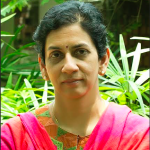 The focus of her research is temple architecture, iconography and epigraphy. She is the author of seven books: History and Culture of Tamil Nadu: As Gleaned from the Sanskrit Inscriptions (two volumes), Vishnu Temples of South India (four volumes) and Sanskrit Education and Literature in Ancient and Medieval Tamil Nadu. She wrote the text for a coffee-table book, Snapshots of A Bygone Era: A Century of Images. Chithra co-edited South India Heritage: An Introduction containing approximately 500 articles on various aspects of the heritage and culture of South India. She has also compiled Kalakshetra Reflections: Sculpture.
The focus of her research is temple architecture, iconography and epigraphy. She is the author of seven books: History and Culture of Tamil Nadu: As Gleaned from the Sanskrit Inscriptions (two volumes), Vishnu Temples of South India (four volumes) and Sanskrit Education and Literature in Ancient and Medieval Tamil Nadu. She wrote the text for a coffee-table book, Snapshots of A Bygone Era: A Century of Images. Chithra co-edited South India Heritage: An Introduction containing approximately 500 articles on various aspects of the heritage and culture of South India. She has also compiled Kalakshetra Reflections: Sculpture.
Chithra Madhavan has an M.A. and M.Phil. from the Department of Indian History, University of Madras, and a Ph.D. from the Department of Ancient History and Archaeology, University of Mysore. She is the recipient of two post-doctoral fellowships from the Department of Culture, Government of India, and from the Indian Council of Historical Research, New Delhi. Chithra is a guest lecturer at many institutions in Chennai like Kalakshetra Foundation, the Arts Management programme of DakshinaChitra, and the Asian College of Journalism. She frequently delivers lectures on heritage-related topics in various places in India.
Abstract of the talk
The temples of India, which reflect cosmic symbolism were, and still are, constructed on the space called Vastu Purusha Mandala, essentially a square, from which rises the temple. This Mandala is the representation of the manifest form of the unmanifested being. While this was the underlying principle of all the temples, regional variations, especially the Nagara of North India and the Dravida, essentially of Tamil Nadu and some other Southern regions, and Vesara, loosely described as a combination of the two, came to be the main styles of architecture in India.
The architectural styles were, to a great extent, decided by the stone which was locally available. For example, the temples of the Vesara style found in Karnataka of the Hoysala dynasty were constructed of soft stone (chloritic schist). Out of this stone, no tall structure could be constructed. Therefore the Hoysala temples are medium-sized, but with a focus of intricate sculpture which the stone lent itself to.
An integral part of the ethos of temples is the sculptural component. The sculptures were made according to the principles of the Shilpa Sastras, with iconometry (tala mana) being a very important base for the sculptors. Stylistically, sculptures vary from place to place and even within the same place from era to era. Even within the timeframe of one dynasty, the sculptural style shows variation. These changes may be subtle, but it is nevertheless fascinating to see them slowly unfurl.
The different styles and methods of construction, as also sculptural styles and aesthetics, will be dealt with in the course of these lectures.
Video